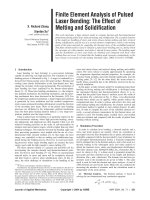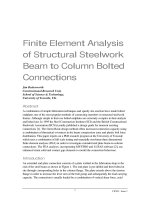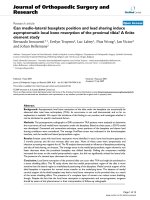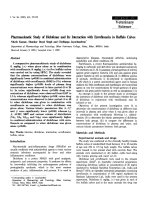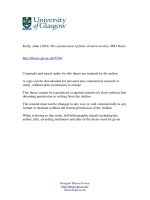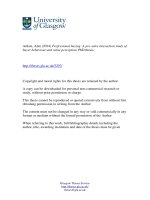Finite element study of tunnel soil pile interaction
Bạn đang xem bản rút gọn của tài liệu. Xem và tải ngay bản đầy đủ của tài liệu tại đây (4.65 MB, 160 trang )
FINITE ELEMENT STUDY OF TUNNEL-SOIL-PILE
INTERACTION
by
Cheng Ch’ng Yih B. Eng. (Hons)
A thesis submitted in partial fulfillment of the
requirements for the degree of
Masters of Engineering
National University of Singapore
2003
1
ACKNOWLEDGEMENTS
The author wishes to express his sincere gratitude and thanks to his supervisor, Dr
Ganeswara Rao Dasari, who has been an endless source of ideas and inspiration. His
guidance and help rendered throughout the candidature of the author is much appreciated.
The author also wishes to thank his co-supervisors, A/P Leung Chun Fai and Prof Chow
Yean Khow for their encouragement and advice given, especially during the fortnightly
meetings.
The assistance of Mr. Yeo Eng Hee from the Supercomputing and Visualisation Unit and
Mr. Kwa Lam Koon from the Engineering Information Technology Unit for facilitating the
use of computational resources is also acknowledged.
The completion of this thesis would also not be possible without the invaluable support of a
dear friend, Ms. Chew Puey Lu. Last but not least, the author wishes to extend his thanks to
all friends and family who has provided moral support without whom the completion of this
thesis would not have been possible.
i
FINITE ELEMENT STUDY OF TUNNEL-SOIL-PILE INTERACTION
Cheng Ch’ng Yih
National University of Singapore
ABSTRACT
This study was initiated to assess the effects of tunneling induced ground movements on
adjacent pile foundations. Current methods of analyzing such interaction behaviour involve a
two stage uncoupled approach which is subject to major limitations. A novel kinematic FE
model, called Displacement Controlled Model (DCM) which simulates soil convergence
around the excavated tunnel boundary is first developed to obtain the realistic displacement
field around a deforming tunnel. This model was subsequently applied to the analysis of
tunnel-soil-pile interaction in three-dimensional (3D) space.
Computed ground movements from the back analysis of numerous greenfield case histories
are in good agreement with field data thus verifying the usefulness of the DCM developed
for this study. A strain dependant constitutive model accounting for stiffness non-linearity
was used to obtain realistic ground movement profiles. Subsurface soil displacements and
shape are also predicted to a reasonable degree of accuracy. Emphasis was placed on
obtaining correct displacement shape as it is important for assessing induced bending stresses
in structures and services. Realistic computed displacement magnitudes and shape around a
deforming tunnel indicate the suitability of the method in analyzing complex tunnel-soilstructure problems.
ii
Sixty five tunnel-soil-pile interaction parametric analyses were performed to investigate in
detail the various factors affecting the performance of single piles. Computed induced pile
bending moments (BM) and axial forces (P) generally agrees in trend with current findings.
The study reveals that for piles in close proximity to the tunnel (less than 1 tunnel diameter),
the induced BM could be close to its ultimate capacity. When the pile head is fixed (rotation
and displacement) computed results indicate that the pile may fail in tension depending on
pile geometry, soil type and relative position of the pile tip with respect to tunnel axis level.
This is due to the small relative displacements required to fully mobilize skin friction even at
small volume loss magnitudes.
Back analyses of two case histories indicate fair agreement between computed and test results
with regards to maximum induced pile BM and P. The first analysis corresponded to a single
pile centrifuge test while the second was performed for a two by two pile group field case.
iii
TABLE OF CONTENT
ACKNOWLEDGEMENTS................................................................................................................i
ABSTRACT ...........................................................................................................................................ii
TABLE OF CONTENT ....................................................................................................................iv
LIST OF FIGURES ............................................................................................................................vi
LIST OF TABLES................................................................................................................................x
NOTATIONS AND ABBREVEATIONS.....................................................................................xi
CHAPTER 1..........................................................................................................................................1
INTRODUCTION ..............................................................................................................................1
1.1
Background ..........................................................................................................................1
1.2
Objectives and Scope of Study..........................................................................................4
1.3
Organisation of Thesis .......................................................................................................5
CHAPTER 2..........................................................................................................................................7
BACKGROUND THEORY AND LITERATURE REVIEW ...................................................7
2.1
Introduction .........................................................................................................................7
2.2
Tunnelling Induced Ground Movements........................................................................7
2.2.1
Empirical Methods.....................................................................................................8
2.2.2
Analytical and Quasi-Analytical Methods.............................................................12
2.2.3
Numerical Methods .................................................................................................15
2.2.3.1.
Techniques Simulating Plane Strain Tunnelling .........................................16
2.2.3.2.
Soil Constitutive Models ................................................................................17
2.2.3.3.
Implications......................................................................................................19
2.3
Tunnel-Soil-Pile Interaction.............................................................................................19
2.3.1
Field Observations ...................................................................................................23
2.3.2
Laboratory Testing...................................................................................................24
2.3.3
Predictive Methods ..................................................................................................28
2.4
Summary.............................................................................................................................31
CHAPTER 3........................................................................................................................................33
DISPLACEMENT CONTROLLED MODEL & ITS APPLICATION TO PREDICTION
OF TUNNELLING INDUCED GROUND MOVEMENTS .................................................33
3.1
Introduction .......................................................................................................................33
3.2
Deformation Mechanism .................................................................................................33
3.2.1
Displacement Controlled Method (DCM) ...........................................................35
3.2.2
Implementation of DCM in FE analyses..............................................................40
3.3
Soil Constitutive Model....................................................................................................41
3.4
Methodology ......................................................................................................................44
3.5
Case Studies........................................................................................................................45
3.5.1
Heathrow Trial Tunnel (Type 2)............................................................................47
3.5.2
Loganathan’s Centrifuge Experiment ...................................................................54
3.5.3
Green Park Tunnel ..................................................................................................58
3.5.4
Mexico City Sewer Tunnel......................................................................................60
3.5.5
Bangkok Sewer Tunnel............................................................................................63
3.6
Discussion ..........................................................................................................................65
iv
CHAPTER 4........................................................................................................................................68
TUNNEL SOIL PILE INTERACTION STUDIES ...................................................................68
4.1
Introduction .......................................................................................................................68
4.2
FE Analysis ........................................................................................................................69
4.2.1
Mesh Dimensions and Properties..........................................................................70
4.2.2
Boundary Conditions...............................................................................................71
4.3
Soil and Pile Properties.....................................................................................................72
4.4
Interface Constitutive Model...........................................................................................73
4.5
Displacements and Calculation of BM and P ...............................................................76
4.5.1
Pile Performance at Different Relative Pile Tip to Tunnel Axis Levels (Yp) ..78
4.5.2
Pile Performance at Different Soil Stiffness (Gmax/p’) ........................................81
4.5.3
Pile Performance at Different Volume Loss Magnitudes (Vl) ..........................86
4.5.4
Pile Performance at Different Horizontal Offset From Tunnel Centre (X)...88
4.5.5
Pile Performance with Different Pile Head Fixity Conditions..........................93
4.6
Summary.............................................................................................................................94
CHAPTER 5........................................................................................................................................96
CASE STUDIES OF TUNNEL-SOIL-PILE INTERACTION ...............................................96
5.1
Analysis of Loganathan et al. (2000) Test 3 ..................................................................96
5.1.1
Details of Analysis....................................................................................................96
5.1.2
Results and Discussion............................................................................................98
5.2
Analysis of North East Line (NEL) Mass Rapid Transit (MRT) Project .............. 100
5.2.1
Background ............................................................................................................ 100
5.2.2
Details of Analysis................................................................................................. 102
5.2.2.1.
Mesh Dimensions ........................................................................................ 102
5.2.2.2.
Material Properties ....................................................................................... 104
5.2.2.3.
Volume loss and convergence point ......................................................... 106
5.2.3
Results and Discussion......................................................................................... 107
5.2.3.1.
Induced Pile Stresses (BM and P).............................................................. 107
5.2.3.2.
Induced Pile and Soil Displacements........................................................ 110
5.3
Summary.......................................................................................................................... 116
CHAPTER 6..................................................................................................................................... 118
CONCLUSIONS ............................................................................................................................. 118
6.1
Work reported in the thesis .......................................................................................... 118
6.1.1
Displacement Controlled Method ...................................................................... 118
6.1.2
Tunnel-Soil-Pile Interaction Studies................................................................... 119
6.2
Recommendations for further work............................................................................ 121
6.2.1
Consolidation analysis .......................................................................................... 121
6.2.2
Pile groups.............................................................................................................. 122
6.2.3
Tunnel-Soil-Structure Interaction....................................................................... 122
6.2.4
Improvements in Deformation Mechanics ....................................................... 122
REFERENCES ................................................................................................................................ 124
APPENDIX A................................................................................................................... A1
v
LIST OF FIGURES
Fig. 2.1.
Fig. 2.2.
Fig. 2.3.
Fig. 2.4.
Fig. 2.5.
Fig. 2.6.
Fig. 2.7.
Fig. 2.8.
Fig. 2.9.
Fig. 2.10.
Fig. 2.11.
Fig. 2.12.
Fig. 2.13.
Fig. 2.14.
Fig. 2.15.
Fig. 3.1.
Fig. 3.2.
Fig. 3.3.
Fig. 3.4.
Fig. 3.5.
Fig. 3.6.
Fig. 3.7.
Fig. 3.8.
Fig. 3.9.
Fig. 3.10.
Fig. 3.11.
Fig. 3.12.
Fig. 3.13.
Fig. 3.14.
Fig. 3.15.
Gaussian curve approximating transverse surface settlement trough.....................8
Variation of trough width parameter K with depth for subsurface settlement
profiles above tunnels in clays (Mair et al., 1993) ....................................................10
Variation of normalized i parameter with depth (Grant and Taylor, 2000).........11
Non-uniform soil displacement around tunnel boundary (Loganathan and
Poulos, 1998).................................................................................................................15
Wider surface settlement trough in FE analysis (Stallebrass et al., 1996).............18
Surface settlement trough from 2D and 3D FE analysis (Dasari et al., 1996) ....19
Mechanisms of pile failure due to tunneling induced ground movements ..........21
Displacement profile of soil and pile with depth (Lee et al., 1994).......................24
Zone of high pile settlements (Morton and King, 1979)........................................25
Experimental setup of centrifuge test (Hergarden et al., 1996) .............................25
Location of pile relative to tunnel in centrifuge tests by Loganathan et al. (2000)
.........................................................................................................................................26
Maximum induced pile bending moment and axial force (Loganathan et al.,
2000) ...............................................................................................................................27
Zone of large pile settlements (Jacobsz, 2001).........................................................28
Computed pile horizontal displacement approximately similar in shape and
magnitude to imposed free field soil displacement (Chen et al., 1999) ................29
Development of pile bending moment and axial forces with advancement of
tunnel face (Mroueh and Shahrour, 1999) ................................................................30
Displacement vector plot around tunnel showing high invert heave in relation to
crown settlement (Stallebrass et al., 1996).................................................................34
Pitfalls associated with stress based FE analysis of tunnel excavation .................35
Uniform and nonuniform convergence around excavated tunnel ........................36
Displacement vector plots from centrifuge tests (a) Mair (1979) and (b)
Hagiwara et al. (1999)...................................................................................................37
Variation of i parameter and focus point with depth (Grant and Taylor, 2000).39
Proposed displacement mechanism around excavated tunnel...............................40
General variation of shear stiffness with deviatoric strain .....................................42
Variation of shear stiffness with deviatoric strain....................................................43
Convergence of solution to constant value based on no. of elements in mesh ..45
Comparison of surface settlement troughs...............................................................49
Comparison of horizontal displacements at various offsets from tunnel centre 49
Comparison of surface settlement troughs using stress and displacement based
methods..........................................................................................................................51
Comparison of horizontal displacements at various offsets from tunnel centre
using stress and displacement based methods..........................................................51
Localising effect (displacements) of kinematic method compared to stress based
methods..........................................................................................................................52
Necessity of stiffness nonlinearity to obtain realistic predictions of settlement
trough .............................................................................................................................53
vi
Fig. 3.16.
Fig. 3.17.
Fig. 3.18.
Fig. 3.19.
Fig. 3.20.
Fig. 3.21.
Fig. 3.22.
Fig. 3.23.
Fig. 3.24.
Fig. 3.25.
Fig. 3.26.
Fig. 4.1.
Fig. 4.2.
Fig. 4.3.
Fig. 4.4.
Fig. 4.5.
Fig. 4.6.
Fig. 4.7.
Fig. 4.8.
Fig. 4.9.
Fig. 4.10.
Fig. 4.11.
Fig. 4.12.
Fig. 4.13.
Fig. 4.14.
Fig. 4.15.
Fig. 4.16.
Fig. 4.17.
Fig. 4.18.
Fig. 4.19.
Fig. 4.20.
Fig. 4.21.
Necessity of stiffness nonlinearity to obtain realistic predictions of horizontal
displacements (x = 6.3m) ............................................................................................53
Transverse settlement troughs for (a) Test 1 and (b) Test 3. .................................56
Horizontal displacements (x = 5.5m) and settlements above tunnel crown for (a)
Test 1 and (b) Test 3 ....................................................................................................57
Observed and predicted surface settlement for Green Park Tunnel ....................59
Observed and predicted settlement above tunnel crown for Green Park Tunnel
.........................................................................................................................................60
Observed and predicted settlement troughs for Mexico City Sewer Tunnel.......61
Observed and predicted horizontal displacements at an offset of 2.5m and 4.5m
from tunnel centreline..................................................................................................62
Observed and predicted settlement trough for Bangkok Sewer Tunnel..............64
Observed and predicted horizontal displacement (x = 4m) and vertical
settlement above tunnel crown for Bangkok Sewer Tunnel ..................................65
“Squeezing” of tunnel lining in different soils .........................................................66
Variation of Focus Point with C/Dt ratio .................................................................67
Typical mesh used for parametric study....................................................................70
Soil constitutive model used for tunnel-soil-pile interaction studies ....................72
Skin friction behaviour between pile and soil interface ..........................................74
Plot of sliding displacement with shear stress (Tsubakihara and Kishida, 1993) 75
Notations used in finite difference equations for (a) bending moment and (b)
axial force.......................................................................................................................77
Horizontal displacement (a) and bending moment (b) profiles along pile length
.........................................................................................................................................80
Settlement (a) and axial force (b) profile along pile length.....................................80
Variation of maximum induced bending moment with relative Yp levels............81
Pile (a) horizontal displacement and (b) bending moment profile for Yp of -1Dt
.........................................................................................................................................83
Pile (a) settlement and (b) axial force profile for Yp of -1Dt ...................................83
Pile (a) horizontal displacement and (b) bending moment profile for Yp of 0Dt 84
Pile (a) settlement and (b) axial force profile for Yp of 0Dt ....................................84
Pile (a) horizontal displacement and (b) bending moment profile for Yp of +1Dt
.........................................................................................................................................85
Pile (a) settlement and (b) axial force profile for Yp of +1Dt .................................85
Variation of (a) maximum induced bending moment and (b) axial forces with
tunnel volume loss for Yp = -1Dt ...............................................................................87
Variation of (a) maximum induced bending moment and (b) axial forces with
tunnel volume loss for Yp = 0Dt .................................................................................87
Variation of (a) maximum induced bending moment and (b) axial forces with
tunnel volume loss for Yp = +1Dt ..............................................................................88
Comparison of (a) horizontal and (b) vertical soil displacement profiles at 1Dt
and 2Dt from tunnel centre.........................................................................................89
Variation of maximum induced bending moment with horizontal distance from
tunnel centre ..................................................................................................................91
Variation of maximum induced axial force with horizontal distance from tunnel
centre ..............................................................................................................................91
Varying degrees of skin friction being mobilized.....................................................92
vii
Fig. 4.22.
Fig. 4.23.
Fig. 5.1.
Fig. 5.2.
Fig. 5.3.
Fig. 5.4.
Fig. 5.5.
Fig. 5.6.
Fig. 5.7.
Fig. 5.8.
Fig. 5.9.
Fig. 5.10.
Fig. 5.11.
Fig. 5.12.
Fig. 5.13.
Fig. 5.14.
Fig. 5.15.
Fig. 5.16.
Fig. 5.17.
Fig. 5.18.
Fig. 6.1.
Fig. A.1.
Fig. A.2.
Fig. A.3.
Fig. A.4.
Fig. A.5.
Fig. A.6.
Fig. A.7.
Fig. A.8.
Relative position of pile tip to zone of large displacements for pile (Yp = +1Dt)
.........................................................................................................................................92
Comparison of pile maximum (a) induced bending moment and (b) axial force
for fixed and free pile head case .................................................................................93
Configuration of centrifuge model set up.................................................................97
Computed pile and soil (far field) (a) horizontal and (b) vertical displacements.99
Variation of induced pile (a) bending moment and (b) axial force for Test 3.....99
Comparison of maximum induced bending moment and axial force for pile in
Test 3 (Loganathan et al.,2000)................................................................................ 100
Viaduct pier, pile and tunnel layout ........................................................................ 101
Plan view of relative pile-tunnel location drawn to scale..................................... 102
Mesh and pile geometry with soil strata ................................................................. 103
Variation of normalised stiffness with deviatoric strain for Hong Kong
Completely Decomposed Granite (Grade V)........................................................ 105
Nonlinear stiffness variation of weathered Hong Kong granitic soil (Ng et al.,
2000) ............................................................................................................................ 105
Induced bending moment along pile P1 for different soil stiffness due to (a) SB
and (b) subsequent NB tunnel excavation ............................................................. 108
Induced bending moment along pile P2 for different soil stiffness due to (a) SB
and (b) subsequent NB tunnel excavation ............................................................. 109
Induced axial force along pile P1 for different soil stiffness due to (a) SB and (b)
subsequent NB tunnel excavation........................................................................... 109
Induced axial force along pile P2 for different soil stiffness due to (a) SB and (b)
subsequent NB tunnel excavation........................................................................... 110
Development of surface settlement trough with SB and NB tunnel excavation
...................................................................................................................................... 111
Pile horizontal displacement after (a) SB and (b) NB tunnel excavation .......... 113
Comparison of horizontal displacement for pile (a) P1 and (b) P2 with
corresponding far field soil displacements............................................................. 115
Comparison of settlement for pile (a) P1 and (b) P2 with corresponding far field
settlement.................................................................................................................... 115
Contour plot of displacements for deformed pile group mesh (x1000)............ 116
Improved kinematic model to simulate tunnel convergence .............................. 123
Mesh density of (a) 30, (b) 84, (c) 182 and (d) 668 elements used for
convergence study .......................................................................................................A1
Mesh dimension for all analysed case histories in Chapter 3 ................................A2
Vertical and horizontal changes in tunnel lining diameter before and after
compensation grouting for London Docklands Light Railway Lewisham
Extension twin tunnel project (Lee, 2002)...............................................................A3
Comparison of BM and P for total stress and effective stress analysis (Vl = 1%,
Gmax/p’=400, Yp = -1Dt, X=1Dt) ...............................................................................A6
Surface settlement trough for with (far field ) and without presence of pile......A6
Effect of modeling slip between pile and soil using interface elements for (a)
bending moment and (b) axial force (Vl = 3%, Yp = -1Dt, X=1Dt) ....................A7
Pile and rebar dimensions...........................................................................................A8
Pile (a) horizontal displacement and (b) bending moment profile for Yp = -1Dt ...
........................................................................................................................................A8
viii
Fig. A.9.
Fig. A.10.
Fig. A.11.
Fig. A.12.
Fig. A.13.
Fig. A.14.
Fig. A.15.
Fig. A.16.
Fig. A.17.
Fig. A.18.
Fig. A.19.
Fig. A.20.
Fig. A.21.
Fig. A.22.
Fig. A.23.
Pile (a) settlement and (b) axial force profile for Yp = -1Dt...................................A9
Pile (a) horizontal displacement and (b) bending moment profile for Yp =
-1Dt ............................................................................................................................A9
Pile (a) settlement and (b) axial force profile for Yp = 0Dt .............................A10
Pile (a) horizontal displacement and (b) bending moment profile for Yp =
+1Dt ........................................................................................................................A10
Pile (a) settlement and (b) axial force profile for Yp = +1Dt ..........................A11
Variation of maximum induced pile (a) bending moment and (b) axial force
for Yp = -1Dt ..........................................................................................................A11
Variation of maximum induced pile (a) bending moment and (b) axial force
for Yp = 0Dt............................................................................................................A12
Variation of maximum induced pile (a) bending moment and (b) axial force
for Yp = +1Dt.........................................................................................................A12
Pile (a) bending moment and (b) axial force variation for Yp = -1Dt ............A13
Pile (a) bending moment and (b) axial force variation for Yp = 0Dt..............A13
Pile (a) bending moment and (b) axial force variation for Yp = +1Dt...........A14
Pile (a) bending moment and (b) axial force variation for Yp = -1Dt ............A14
Pile (a) bending moment and (b) axial force variation for Yp = 0Dt..............A15
Pile (a) bending moment and (b) axial force variation for Yp = +1Dt...........A15
Contour plot of displacement magnitudes after SB and NB tunnel excavation.
..................................................................................................................................A16
ix
LIST OF TABLES
Table 3.1.
Table 3.2.
Table 4.1.
Table 4.2.
Table 4.3.
Table 4.4.
Table 5.1.
Table 5.2.
Table 5.3.
Table A.1.
Parameters to define stiffness variation of various clays....................................43
Tunnel geometry, soil and analysis details ............................................................46
List of constant mesh dimensions for parametric study ....................................71
Soil stiffness values used for parametric study ....................................................73
Summary of soil and pile properties......................................................................73
List of factors varied and kept constant ...............................................................78
Summary of properties assigned to soil, pile and soil-pile interface.................98
Summary of properties assigned to soil, pile and soil-pile interface for NEL
analysis .................................................................................................................... 106
Input volume loss and β magnitudes for analysis ............................................ 106
Calculation of Gmax/p’ ratio for input in analysis (Viggiani and Atkinson, 1995)
..................................................................................................................................A17
x
NOTATIONS AND ABBREVEATIONS
English alphabet, upper case
BM
= induced pile bending moment
C
= soil cover above tunnel
Dp
= pile diameter
Dt
= excavated tunnel diameter
E
= Young’s modulus
Ep
= pile Young’s modulus
EpI
= pile flexural stiffness
G
= soil shear modulus
Gp
= difference between cutter head and tunnel lining diameter (Gap Parameter Method)
K
= trough width parameter
Ko
= coefficient of earth pressure at rest
Lp
= pile length
P
= induced pile axial force
R
= excavated tunnel radius
Ro
= overconsolidation ratio defined as pc’/p’
S
= soil settlement induced by tunneling
U*3D
= parameter accounting for three dimensional heading effects (Gap Parameter
Method)
Vl
= tunnel volume loss
X
= horizontal distance between pile and tunnel centre
Yp
= pile tip level relative to tunnel axis level (positive for pile tip above tunnel axis)
xi
English alphabet, lower case
a
= radius of point sink
fcu
= concrete crushing stress
g
= gravitational acceleration constant (9.81ms-2)
i
= horizontal distance from tunnel centre to point of inflexion of the settlement
trough
n
= parameter controlling rate of stiffness degradation within small strain region
p’
= mean normal effective stress
pc’
= preconsolidation pressure
x
= horizontal offset from tunnel centre
r
= radial distance from point sink
u1
= pile displacement in the transverse tunnel direction
u3
= pile displacement in the vertical direction
z
= depth below ground surface
zo
= depth to tunnel axis level
Greek alphabet
εq
= deviatoric strain
ϖ
= parameter accounting for workmanship quality (Gap Parameter Method)
φ’
= effective friction angle of soil
β
= parameter denoting focus point of tunnel (DCM)
µ
= coefficient of friction
γ
= slip displacement for interface element
xii
τ
= skin friction / shear stress
τ1
= skin friction mobilized along pile longitudinal axis
τ2
= skin friction mobilized transverse to pile longitudinal axis
ν
= Poisson ratio
σ’
= soil effective stress
Subscripts
cr
= cracking moment
equi
= τ 1 + τ 2 = equivalent shear stress
h
= horizontal direction
lim
= limiting elastic slip or skin friction
max
= maximum magnitude
min
= minimum magnitude
nc
= normally consolidated
oc
= over consolidated
sec
= secant stiffness
tan
= tangent stiffness
ult
= ultimate bending moment or tensile force
v
= vertical direction
2
2
xiii
CHAPTER 1
INTRODUCTION
1.1
Background
Recent advances in tunneling technology have enabled underground space to be exploited to
a greater extent as numerous techniques and machines are available to efficiently excavate
through almost any soil condition. This advancement is reflected in the large number of
tunnel excavation projects proceeding concurrently throughout the world, mostly in densely
populated areas where land is scarce. It is therefore inevitable that some form of tunnel-soilstructure interaction will occur as the zone of influence caused by tunneling induced ground
movements affects close proximity structures, foundations and services. Although such
circumstances are inherently undesirable, tunnel construction in such areas may be dictated
by geographical and or economic constraints.
A form of tunnel-soil-structure interaction that has recently received much attention
concerns the effect of tunneling induced ground movements on piles. This is mainly
attributed to the fact that more tunnels are being excavated close to piled foundations (Lee et
al., 1994, Coutts and Wang, 2000, Tham and Deutscher, 2000) which consequently results in
additional lateral and vertical forces induced on the pile. Depending on the fixity conditions
at the pile head and relative position of the pile and its tip to the tunnel, failure could be
induced to the deep foundation by exceeding a combination of serviceability and/or ultimate
limit states.
1
To avoid the hazard of damaging close proximity piles, a method is required to systematically
and reliably assess the performance of piles subjected to tunneling induced ground
movements. The effect of construction method, ground conditions, soil type and pile-tunnel
geometry should be accounted for in order to obtain realistic predictions that are suitable for
decision making purposes.
Current methods of analyzing pile performance subjected to tunneling induced ground
movement involves a two stage uncoupled approach where greenfield soil movements are
approximated by a quasi-analytical method (Loganathan and Poulos, 1998), subsequently
applying the obtained free field ground movements on soil elements surrounding the pile via
boundary element programs (Chen et al., 1999, Loganathan et al., 2001). In these numerical
programs, the pile is either modeled as a beam or elastic continuum while the soil is modeled
as an elastic continuum. Although simple and easy to use, this approach to estimating pile
performance subjected to tunneling induced ground movements does not account for
coupled interaction where induced pile axial loads could result in additional moments
depending on the magnitude of pile deformation under lateral loading (Chen and Poulos,
1999). This suggests that a more rigorous approach to analyzing tunnel-soil-pile interaction is
required to obtain a better understanding and insight into the various factors affecting piled
foundations.
One such tool to analyse complex tunnel-soil-pile interaction in a more rigorous manner is
the FE method where coupled interaction is simulated. Although tunneling is essentially a 3D
problem, 3D FE analysis (construction sequence modeled) is resource intensive. Assuming
experienced tunnellers and good construction technique are present in a tunnel excavation
project, the most severe loading on a close proximity pile would correspond to the case in
2
which tunnel face has past the pile location, ie. uniform displacements along tunnel boundary
in the longitudinal direction. 3D FE studies by Mroueh and Shahrour (2002) and field data
from Coutts and Wang (2000) supports this intuitive assumption as although pile bending is
inevitably induced in the longitudinal tunnel direction, maximum bending moments are
developed in the transverse tunnel direction when tunnel heading has passed the pile
location. Thus the problem can be simplified to a 3D FE analysis in geometry but with
uniform soil displacements along the tunnel boundary in the longitudinal direction.
Plane strain tunnel excavation is commonly simulated using the FE method by various
techniques such as the Convergence Confinement Method (Panet and Guenot, 1982),
Volume Loss Method and Gap Parameter Method (Lee et al., 1992). In these methods, soil
convergence around the tunnel is simulated by releasing insitu soil stresses from equilibrium
conditions, hence the term “stress based”. This is performed by (i) removing elements that
form the excavated tunnel or (ii) releasing fixities around the excavated tunnel boundary.
Although widely accepted, the application of the above mentioned methods to 2D FE tunnel
analyses usually result in incorrect displacement profiles. Computed settlement troughs are
wider than field data coupled with high far field settlements while subsurface displacements
are unreliable due to the incorrect surface settlement trough.
This shortcoming can be partly improved by using advanced soil constitutive models as in
Lee and Rowe (1989), Stallebrass et al. (1996), Addenbrooke et al. (1997), Simpson (1996). As
noted by Stallebrass et al. (1996) and observed in NATM tunnelling studies by Dasari et al.
(1996), the inclusion of advanced soil models have only resulted in limited success. This
limited success may be sufficient for ground movement prediction, but may not be so for
tunnel-soil-pile interaction as the induced forces in the pile are sensitive to deformed shape.
3
This therefore suggests a need for an improved method capable of predicting the
displacement field around a converging tunnel to an acceptable degree of accuracy before
meaningful FE analysis of tunnel-soil-pile interaction study can be performed.
1.2
Objectives and Scope of Study
Due to the inherent nature of the problem where a pile is cast/driven long before a tunnel is
excavated along side, it is very difficult to instrument the pile to obtain induced bending
moments and axial forces. Therefore, numerical tools could be used to gain insight into the
problem. This study intends to provide a reliable and sound numerical method to predict pile
responses subjected to tunneling induced ground movement to supplement the few
documented field cases available.
The objectives of the present research study are as follows:
(a)
To develop a novel Displacement Based Model (DCM) capable of predicting plane
strain tunneling induced ground movements accurately using FE methods.
(b)
To obtain realistic and reasonable predictions of pile structural performance using the
DCM in 3D tunnel-soil-pile interaction studies.
The scope of the research encompasses three main parts. The first part involves developing a
new FE model to obtain the correct plane strain displacement field around the tunnel by
assuming a deformation mechanism around the excavated tunnel. Numerous greenfield
tunnel case histories in clay are back analysed to verify the applicability of the method. The
tunnels located are at various tunnel cover to tunnel diameter (C/Dt) ratios thus providing an
adequate collection of cases to verify the developed method.
4
In the second part of this study, DCM was used for tunnel-soil-pile interaction analysis to
study the various factors influencing pile performance when subjected to tunneling induced
ground movements. A hypothetical pile and tunnel problem was analysed while varying the
below mentioned factors:
i)
soil stiffness
ii)
volume loss (Vl)
iii)
pile head fixity conditions (rotation and displacement)
iv)
pile length, ie. pile tip position relative to tunnel axis level (Yp)
v)
pile horizontal distance from tunnel (X)
C/Dt ratio, pile diameter (Dp) and pile Young’s modulus (Ep) were assumed constant for all
analyses. The parameters investigated are induced bending moments and axial forces, in
particular their maximum magnitudes.
Finally, DCM was applied to back analyse two tunnel-soil-pile case histories; one from
centrifuge testing and the other from a field project.
1.3
Organisation of Thesis
Chapter 2 presents a review of the literature relevant to the study of this thesis. This review
covers the various popular methods available to predict plane strain tunneling induced
ground movements and the limitations associated with each method. Also reviewed are the
research efforts in the area of tunnel-soil-pile interaction.
5
The development of the DCM is fully discussed in Chapter 3 with justifications behind the
various assumptions employed in the method. The applicability of the method is verified by
comparison with published field and centrifuge data of tunnels excavated in greenfield
conditions. Comparisons are also made with existing methods used to predict the
displacement field around a deforming tunnel.
Chapter 4 presents a detailed study on tunnel-soil-pile interaction. The impact of various
factors on pile performance is presented to develop a deeper understanding of the problem.
The suitability of the DCM to predict/simulate tunnel-soil-pile interaction is verified in
Chapter 5 by back analysing and comparing computed results with a published centrifuge test
and field case history.
Conclusions of findings presented in this thesis are summarised in Chapter 6 along with
suggestions for further work.
6
CHAPTER 2
BACKGROUND THEORY AND LITERATURE REVIEW
2.1
Introduction
The prediction of tunneling induced ground movements is necessary and important to
prevent potential damage to pre-existing structures, foundations and services in the form of
serviceability (displacements) or ultimate limit states (stress). The engineer responsible for
design and construction of the tunnel should be able to predict these movements to a
reasonable degree of accuracy with the aid of numerous methods that are available to him.
The selection of method would largely depend on the complexity and severity of the tunnelsoil-structure interaction anticipated from the tunnel excavation project and the resources
available to the engineer.
This chapter briefly discusses the features of various methods employed to predict tunneling
induced ground behaviour with the intention of justifying the necessity of FE methods in
analysing tunnel-soil-pile interaction problems and why a new model is required to simulate
2D FE tunneling. Published efforts and current advances in the area of tunnel-soil-pile
interaction are also presented.
2.2
Tunnelling Induced Ground Movements
Various methods are available to the engineer to predict soil deformation due to tunnel
excavation. These methods can be generally categorized as; (i) empirical, (ii) analytical and (iii)
numerical to which each has its merits and limitations.
7
2.2.1
Empirical Methods
For the case of a greenfield tunnel excavation, Peck’s (1969) representation of the transverse
settlement trough in the shape of a Gaussian distribution curve (Figure 2.1) is arguably the
most popular empirical method used to provide a preliminary estimate of the surface
settlement profile. The method offers the advantage of simplicity with only 2 parameters
required as input. The method needs an estimate of volume loss (Vl) and the trough width
parameter (i) to obtain Smax and subsequently the settlement profile. Settlements are generally
negligible beyond an offset of 3i from the tunnel centerline for Peck’s proposed curve.
Offset From Centreline, x
-3i
-2i
-i
0
i
2i
3i
Settlements
negligible
beyond 3i
0.6 Smax
Point of inflexion
Smax
Settlement
Fig. 2.1.
Gaussian curve approximating transverse surface settlement trough
The surface settlement trough and volume loss is approximated by the following equations;
x2
S = S max exp − 2
2i
(2.1)
V = 2π iS max
(2.2)
8
Estimates of volume loss are made by the engineer based on experience, taking into account
the effects of ground conditions, contractor and or operator experience and construction
technique. Unlike volume loss, the trough width parameter is relatively easier to quantify as it
is largely independent of construction method and operator experience (Fujita, 1981; O’Reilly
and New, 1982). Numerous estimates of trough width parameters have been put forward by
researchers based on their collection of field data. However, a comprehensive summary by
Lake et al. (1992) on tunneling data from many countries has shown that the general
variations of i are as such:
•
Approximate relationship
i = Kz o
•
Clays (soft and stiff)
K = 0.4-0.6
•
Sands and gravels
K = 0.25-0.45
where zo is the depth to tunnel axis level. This study complements the various proposals that
K can be assumed as 0.5 for tunnels excavated in clays (O’Reilly and New, 1982; Mair et al.,
1993).
Subsurface settlement profiles are also reasonably approximated by a Gaussian distribution
curve in a similar way as surface settlements. Mair et al. (1993) proposed that at a depth z
below the ground surface, above a tunnel depth of zo, the trough width parameter for tunnels
constructed in clays can be expressed as:
i = K ( zo − z)
(2.3)
0.175 + 0.3251 − z
zo
K=
1 − z
z o
(2.4)
9
The variation of K presented above was obtained from a best fit line to field data from
numerous tunneling projects (Figure 2.2). Trough width parameter is shown to increase with
depth and would be under predicted should a constant value be assumed. Similar patterns of
increase in K was observed in studies by Moh et al. (1996) and Dyer et al. (1996) irrespective
of the soil conditions encountered. Recent centrifuge studies by Grant and Taylor (2000)
show that the proposed variation of K with depth for clays by Mair et al. (1993) provide a
good fit to data obtained from tests within a certain range between ground surface and tunnel
axis level (Figure 2.3). Data showed larger trough width values at the surface and lower values
nearing tunnel axis level compared to corresponding magnitudes obtained using Mair’s (1993)
proposed variation.
Fig. 2.2.
Variation of trough width parameter K with depth for subsurface settlement profiles above
tunnels in clays (Mair et al., 1993)
10
Fig. 2.3.
Variation of normalized i parameter with depth (Grant and Taylor, 2000)
Horizontal movements can be predicted by assuming a particular focus point along the
tunnel centre line. Attewell (1978) and O’Reilly and New (1982) proposed a convergence
point at the tunnel centre for tunnels in clays while Taylor (1995) demonstrated that for
constant volume conditions, the application of Equation 2.2 to represent the variation of K
with depth would yield a convergence point
•
0.175
zo below tunnel axis level.
0.325
Convergence point at tunnel centre
Sh =
x
Sv
zo
S h = 1.65S h max
x2
x
exp − 2
i
2i
(2.5)
11
